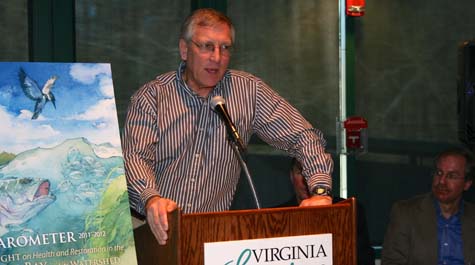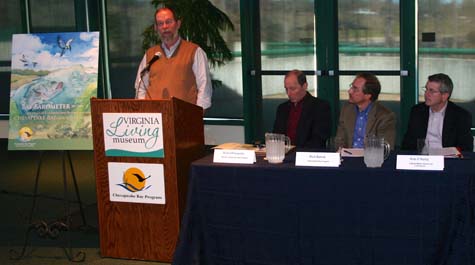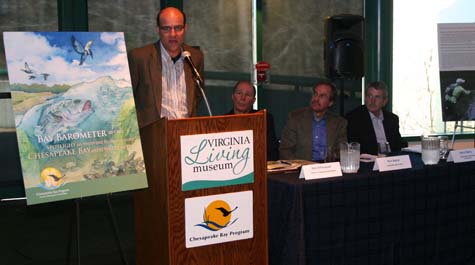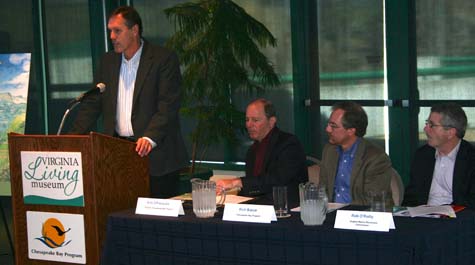VIMS scientists contribute to Bay Barometer report
Annual report says Bay impaired, but
signs of resilience abound
A team of researchers from William & Mary’s Virginia Institute of Marine Science joined with officials from the Chesapeake Bay Program and other agencies to announce the release of the latest Bay Barometer, CBP’s annual report on Bay health and the status of long-term Bay restoration efforts.
The announcement took place during a press conference at the Virginia Living Museum in Newport News, with the delighted cries of visiting school groups providing a fitting backdrop.
The bottom line on Bay health, according to the 2011-2012 Barometer, is that continued restoration actions and success in pollution reduction give cause for optimism, while scientific indicators continue to reflect the reality of an impaired Bay ecosystem.
CBP Director Nick DiPasquale says, “We’re having some long-term success, we’re rebuilding some of the resilience that’s the hallmark of a balanced ecosystem.” “But,” he adds, “we also want to recognize that we have a long way to go. We now have 17.5 million people in this watershed—that’s a lot of rooftops, a lot of parking lots, a lot of human activity that disrupts the natural flows of the environment.”
The Chesapeake Bay Program is a regional partnership that has led and directed Bay restoration since 1983. It comprises Maryland, Pennsylvania, and Virginia; the District of Columbia; the Chesapeake Bay Commission, a tri-state legislative body; the U.S. Environmental Protection Agency, representing the federal government; and participating citizen advisory groups.
Scientists at VIMS play a large role in CBP’s research and monitoring efforts, with programs such as the Winter Blue Crab Dredge Survey, the Seagrass Monitoring and Restoration program, the American Shad Monitoring program, and the Juvenile Seine Survey contributing the data needed to track the health of the Bay and its marine life.
Numerous VIMS faculty also serve on the Bay Program’s Scientific and Technical Advisory Committee and its Goal Implementation teams—the bodies that CBP uses to ensure that its management decisions are based on the best available science. VIMS scientist Kirk Havens is one of two Governor’s appointees to the Scientific and Technical Advisory Committee, where he serves as vice chair.
During the January 31st press conference, a team of five VIMS scientists—Carl Friedrichs, Marjy Friedrichs, Carl Hershner, Rom Lipcius, and Robert “JJ” Orth—answered media questions and provided expert commentary on the specific criteria that CBP uses to gauge Bay health.
Lipcius, who directs the Virginia portion of the baywide Winter Blue Crab Dredge Survey and serves on the Chesapeake Bay Stock Assessment Committee for these iconic crustaceans, sounded a guardedly optimistic note about the status of the Bay’s blue crab stock, which according to the latest survey results included the highest number of juveniles since 1993 but lower numbers of adult females.
"The substantial rise in abundance of juveniles was clearly a response to unprecedented management actions, such as the closure of the winter dredge fishery by the Virginia Marine Resources Commission and partner agencies,” said Lipcius. “The recorded number of spawning age females is a warning signal that requires a risk-averse, prudent management strategy to avert another decline." Crab abundance had declined by 70% before the baywide stock-rebuilding program began in 2008.
Carl Friedrichs, who serves on the CBP’s Scientific & Technical Advisory Committee, discussed how he and other scientists are working to better understand the factors that affect development of low-oxygen dead zones, with the Bay Barometer showing only 34% of Bay waters meeting standards for dissolved oxygen. The most familiar cause of dead zones are the blooms of algae that form when excessive loads of nitrogen—from fertilizers, municipal sewage, and other sources—runoff into coastal waters. When these algae die and sink, they provide a rich food source for bacteria, which in the act of decomposition take up dissolved oxygen from the surrounding environment.
“One area of progress in the last few years has been a better understanding of how the Bay’s dead zone responds to the effects of the wind versus nutrients,” said Friedrichs. The speed and direction of winds can affect the occurrence of dead zones by breaking down the stratification that keeps oxygen-rich surface waters from reaching deeper areas of the Bay. “It's good to separate those effects so that we can most effectively and fairly help agriculture reduce its nutrient inputs,” said Friedrichs. “We don’t want to blame farmers for the wind.”
An important way to better understand and predict the effect of wind, nutrient inputs, and other drivers of Bay health is through computer simulations, with the CBP using a purpose-built computer model to generate some of the data included in the Bay Barometer.
Marjy Friedrichs, who serves on the CBP’s Scientific and Technical Advisory Committee and its Modeling Laboratory Action Team, says “It's absolutely critical that we continue to have a scientifically sound, state-of-the-art model of the Bay and its watershed. The CBP model was used to help establish the pollution reductions required for Bay restoration, and allows us to interpolate between the observations, to help us better understand what’s going on at places and times where we simply don't have measurements. Models are also the best tool we have to better understand what will happen in the future in the Bay.”
She notes that she and colleagues at VIMS are independently checking the Bay model simulations and comparing them with those from multiple different models that simulate the Bay’s dead zone. “This helps to reassure the Bay community that the pollution reductions the CBP is recommending are the correct approach,” says Friedrichs, “and our calculations so far confirm this.”
Orth, who serves on the CBP’s workgroup on submerged aquatic vegetation and directs the VIMS program that monitors the status of seagrasses baywide, described one of the Bay’s most promising signs of resiliency—the rebirth and persistence of seagrasses on the Susquehanna Flats.
“The rapid emergence of these beds shows how quickly bay grasses can recover in response to nutrient reductions,” said Orth, “while their persistence through the aftermath of [tropical storms] Irene and Lee shows the resilience of a healthy Bay ecosystem.” In addition to the continued success of the large grass bed on the Susquehanna Flats, the Bay Barometer reports that grasses in the mid-Bay witnessed dramatic increases.
Hershner, a member of the CBP’s Scientific and Technical Advisory Committee, its goal implementation team, and the Chesapeake Bay TMDL advisory panel, discussed ways that urban and rural landowners can contribute to Bay restoration efforts through conservation landscaping in their own yards and gardens.
“There are a lot of efforts going on around the Bay,” said Hershner. “Here in Virginia, we are actively working with Master Naturalists and Master Gardeners to spread the message of how wise use of fertilizers, creation of rain gardens, and other such techniques by localities, lawn-care companies, and individuals can have a big impact on water quality in local streams and in the Bay.”
The Bay Barometer reports that such efforts—by government, industry, and citizens—have created 240 miles of additional forested buffers and achieved about 20% of the reduction targets for nitrogen and phosphorus called for by the Bay’s “pollution diet” or Total Maximum Daily Loads (TMDLs).
Other restoration accomplishments noted in the Bay Barometer include the opening of 148 river miles to migratory fish through dam removal, and the creation of 15 new sites for public access.
To read the eight-page Bay Barometer in full, visit the website of the Chesapeake Bay program at www.chesapeakebay.net.



















